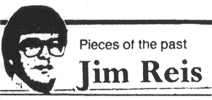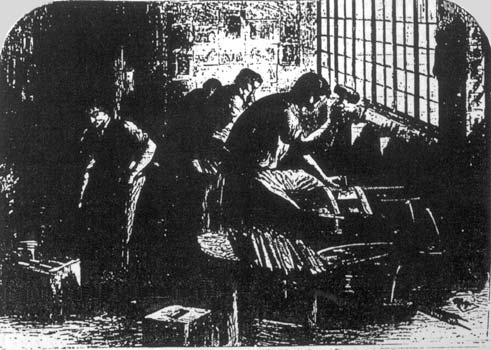[Newspaper]
Publication: The Kentucky Post
Covington, KY, United States
p. 4K, col. 1-3
Factories made wide array of items.
Buttons or bird cages,
business often did well
in Northern Kentucky.
 |
Years ago, just about any product you can think of was made in Northern Kentucky.
Factory production lines included such items as wire nails, pearl buttons, locomotives, ice cream cones, and dolls.
And in many cases, these were not small operations. A Kentucky Post story on Aug. 19, 1914, boasted that among Northern Kentucky's businesses were the largest iron fence works in the world, the largest X-ray machine factory, the largest tile factory, the largest wood-carving plant, and the finest inlaid furniture factory in the United States.
Although some of those early businesses still exist, most have disappeared because of fires, mergers, changing needs, or simply bad economics.
And while a business closing can be a traumatic event for individuals and the community, some were probably for the best just. Just two years before the glowing report on Northern Kentucky's business community, another Kentucky Post story decried child labor and unsanitary conditions which a state inspector said were rampant in Northern Kentucky. State Inspector Madge E. Nave called her inspection of Covington factories "very disheartening and discouraging."
The labor violations she found included mandatory work schedules of more than 10 hours a day and 60 hours a week, unsanitary restrooms, or none at all, work rooms filled with lint and dust, and children working in factories.
In general, she described the conditions in many Covington factories as dreadful and a menace to the public health.
Miss Nave added that while all factories were not like that, clean ones were the exception.
The following is a brief look at some of the business of Northern Kentucky's past. They range from "mom and pop," family-owned businesses to large companies that employed hundreds of people. All were in some way a little unusual.
Wire nails - Most nails used today are made of wire, a 1902 Kentucky Post story said the first steel wire nails made in the United States were made by a Covington priest.
According to the account, Father Joseph Goebel, pastor of St. Augustine's Church, imported one wire-nail machine from Germany in 1875 and formed the Kentucky Wire Nail Works in Covington. The company was such a success that two machines were added.
The American Wire Nail Co. later operated at 15th Street and Madison Avenue in Covington. An 1882 account said the company employed 23 people and produced more than 800 types of nails that were "shipped to all points, including Australia, Cuba, and Japan."
The writer added: "In those countries, they are used to nail up tea chests that bring us our favorite teas, so much relished by our people at their evening repast."
Wire products - At the same time the American Wire Co. was shipping nails all over the country, the Kenton Wire Works was doing the same for other wire products.
The company produced bird cages, rat traps, screens, sieves, baskets, railing, and horse muzzles. The biggest retail users were in Ohio, Indiana, Illinois, and Missouri.
Established in 1878, the Kenton Wire Works was located at Pike Street and Madison Avenue.
 |
| Northern Kentucky was once the home of a multitude of thriving industries, which marketed a wide variety of products. |
An older and larger wire works was operated in Covington on Madison Avenue. The Fred J. Meyers Manufacturing Co. took up a large section of the block between Fourth and Fifth streets. (The Kentucky Post now stands on part of the site).
With just $50, John Meith started the business in 1855 on Twelfth Street. The company later moved to Robbins Street; construction of a five-story building on Madison Avenue began in 1880.
By 1882, the company, now run by Fred Meyers, employed 125 people and was doing more than $175,000 in business annually.
Like the Kenton Wire Works, Meyers Manufacturing made bird cages, sieves, and railing. The company also made iron fence, shutters, flower stands, and fireplace guards.
By 1893 the company had more than 300 workers and sales of more than $1 million.
The company was destroyed a few years later in a fire.
Goldfish - The goldfish center of the Midwestern United States was once said to be the Schlosser farm on Dixie Highway in Kenton County.
Joseph Schlosser, who came to America from Alsace-Lorain in 1847, founded the business. He apparently started out as a meat dealer and had the first meat wagon and icehouse in Covington. The ice was cut from ponds Schlosser owned along Dixie Highway. Then the area was considered either Covington or Ft. Mitchell, but today it is in Ft. Wright.
The Schlosser family got into the goldfish business by accident. One account said they bought some carp to stock their 35 acres of ponds and lakes. The ponds subsequently became popular fishing spots. The fee charged to the fishermen was given to St. John's Orphans Home.
In the 1890's, the Schlosser family added goldfish to the ponds. They once gave several goldfish to an out-of-town visitor. Through that gift, the Schlossers gradually became known throughout the midwest for their goldfish.
By 1917, a writer said the Schlosser's goldfish were valued at several thousand dollars and were in globes all across the country.
The ponds, located behind the old Lookout House restaurant, were drained in 1956 to make way for the construction of I-75 in the Kyles Lane area.
Dolls and Baseballs - Located at the corner of Pike and Russell streets in Covington, P. Goldsmith and Co. manufactured dolls and baseballs in the late 1800's. One story said that in 1882 the company was turning out 75 to 100 dozen dolls and 50 gross of baseballs every day.
The company was named for Philip Goldsmith, an Austrian native, who in the early 1870's became a partner in a Covington company owned by Wolf Fletcher. Fletcher's plant, which made dolls and baseballs, was located at 714 Madison Ave.
About 1878 Goldsmith branched out on his own and in 1880 converted the old Elliston Hotel at Russell and Harvey streets in Covington into the P. Goldsmith Co. A fire struck the plant in 1891, and the next year the company moved into the vacant Hemingray Glass Co. plant at Second Street and Madison Avenue in Covington.
A story about that time said 125 people worked in the four-story factory; the work day began at 7 a.m. and ended at 6 p.m. Monday through Friday. On Saturday, the work day ended at 5 p.m. Most of the employees were women who earned $5 - $6 a week.
A Kentucky Post story said Goldsmith died in July 1894; he drowned while on vacation at Cedar Lake in Wisconsin. The article said Goldsmith was noted for his generosity and that on several occasions he donated dolls to The Kentucky Post for distribution to the poor.
After Goldsmith's death, his sons moved the business to Cincinnati.
Today the dolls that were made at P. Goldsmith are considered antiques, and the company is listed in a guide to collectible dolls.
Pearl Buttons - The buttons were made at the Ohio Valley Pearl Button Co. in Newport from the shells of mussels found in the Ohio River.
The company opened in July of 1892 and was located on the third floor of the Standard Carriage Co. building at Fifth and Washington streets.
A story written a month after the company opened said it employed 30 people and was adding another 30.
Although more than 100 companies were making pearl buttons at the time, all but eight of those companies were on the east coast.
Glassware - Robert Hemingray was considered to be one of the oldest manufacturers of glass in the country when he died in 1896.
Hemingray was born in Johnstown, Pa., and moved to Covington in 1847. He opened a glass manufacturing company under his name in Covington the following year.
Hemingray lived at 219 Garrard St. and operated the company until he died.
A story in 1869 noted that the company turned out 10,000 fruit jars a day. Two years later, Hemingray employees made the news when they were among the first local workers to contribute to a fund set up for victims of the great Chicago fire.
Many of those same workers were temporarily unemployed in November of 1872 when fire in a building next to the Hemingray plant spread to the glass works, destroying much of the completed stock and part of the plant itself. The glass works was located at the foot of Madison Avenue.
After Hemingray's death, the company was apparently reorganized and the new management quickly got into a dispute with city officials over the cost of city water. The conflict was not resolved because in November of the same year - 1898 - the glass works property was sold by order of the courts.
Trains - The A. L. Greer and Co. Locomotive Works opened along a three-block area of Philadelphia Street in Covington, between Third Street and the Ohio River, in 1853.
The massive complex included a foundry, finishing shop, and a setup shop. Equipped at a cost of $100,000, the company was put under the management of Daniel Feger, a veteran of a railroad manufacturing in Reading, Pa. Stories said the company expected to employ about 600 people.
The first locomotive made by the company was named the "Covington" and was put in use by the Covington and Lexington Railroad in April of 1854. Three other locomotives, appropriately named the "Lexington," "Paris," and "Cynthiana," were still in production.
The plant closed in 1855. There was talk of re-opening it the next year, but nothing came of those talks.
Soap - Much like the locomotive business, the soap business did not last long in Covington.
The Eureka Soap Co. was built in Covington in 1881. It was located on Second Street, near Willow Run Creek.
Neighbors objected to the plant because soap at the time was usually made of animal fat and companies had a habit of letting smelly animal carcasses decompose on the property. Company backers said no animal carcasses would be used.
How long the company operated or if it ever opened is not clear. Although a newspaper article said the company was about to open, the name Eureka never appeared in any city directory.
Ice Cream Cones - The two-story ice cream cone plan, located in the rear of 65 Park Avenue in the Clifton section of Newport, was destroyed by fire in December of 1914.
The early morning fire was rather spectacular because of the plant's location on the hill overlooking Newport. Damage was listed at $1,000.
Candy - A more recent addition to the list of businesses was Mrs. Thomas Candies, which was based out of historic Elmwood Hall on Forest Avenue in Ludlow.
Basically a family-run operation, the company made a wide range of chocolates, caramels, and fudge that were sold locally and throughout the world.
The company, which never had more than 12 - 15 employees, closed in July of 1971. The company slogan was "Always Good Taste."
The study of Northern Kentucky history is an avocation of staff writer Jim Reis, who covers suburban Kenton County for The Kentucky Post.